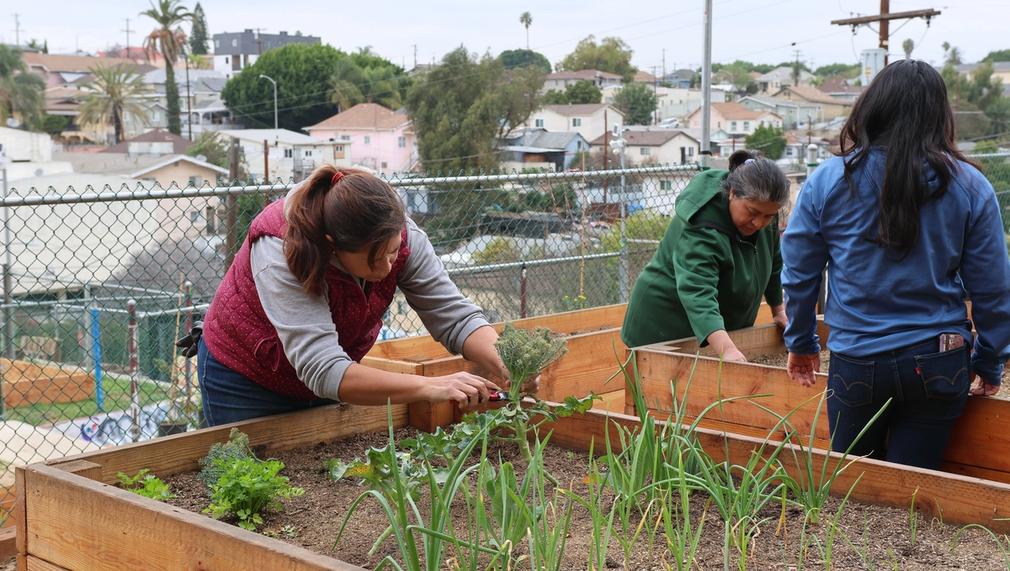Cultivating Community: Greening Affordable Housing
East LA Community Corporation (ELACC) is cultivating community-led green spaces across its affordable housing portfolio in Boyle Heights to build climate resilience and improve resident well-being. This initiative integrates edible community gardens and shaded gathering spaces co-designed and maintained by tenants. It models how greening solutions can be equitably embedded in housing without triggering displacement.

What is the primary issue area that your application will impact?
Green space, park access, and trees
In which areas of Los Angeles will you be directly working?
East LA
In what stage of innovation is this project, program, or initiative?
Pilot or new project, program, or initiative (testing or implementing a new idea)
What is your understanding of the issue that you are seeking to address?
Boyle Heights, a historically disadvantaged neighborhood in East LA, faces compounded environmental and social challenges, including extreme heat, poor air quality, and limited access to green space. These conditions, exacerbated by climate change and decades of systemic inequities, place residents at elevated risk of respiratory and cardiovascular illness and heat-related health issues. As a predominantly Latinx, low-income, and renter-majority community, residents also experience high housing cost burdens and a heightened risk of displacement. Despite these risks, public investment in shade, trees, and gardens remains limited.
By embedding community-designed greening solutions—like micro-forests and food gardens—within permanently affordable housing, ELACC offers a powerful, scalable strategy to improve well-being, foster community, and ensure green benefits remain rooted in the community. This strategy offers a scalable model for equitable, anti-displacement climate adaptation.
Describe the project, program, or initiative this grant will support to address the issue.
ELACC will expand its early-stage greening initiative to integrate climate-resilient, community-accessible green spaces into its affordable housing portfolio. This includes:
Installing and activating three new green spaces across ELACC developments, including a pilot transformation of a city-owned parcel into a publicly accessible micro-forest.
Deepening programming and engagement at existing green spaces: Lorena Terrace Community Garden, Rosa de Castilla Micro-Forest, and El Nuevo Amanecer Organic Beds.
Hosting at least 10 bilingual community workshops in partnership with organizations like Campos de Cultivo, Climate Resolve, and Growing Hope Gardens, covering topics like edible gardening, climate justice, composting, and tree care.
All green spaces are co-designed with residents and remain open to the surrounding community—inviting social connection, cultural expression, and stewardship. These spaces include raised food beds, fruit trees, shade structures, and gathering areas that serve as both functional infrastructure and sources of pride.
Crucially, ELACC’s approach is rooted in anti-displacement values. All properties are permanently affordable, and greening efforts are guided by tenants to guarantee that environmental benefits stay with those who need them most. This counters the typical pattern of green gentrification by combining community empowerment, affordability, and nature access.
Describe how Los Angeles County will be different if your work is successful.
If successful, this initiative will model how green infrastructure can be equitably embedded within affordable housing—improving environmental quality and tenant well-being without triggering displacement. Boyle Heights will be greener, cooler, and more resilient, with:
Expanded canopy and green cover in an area with <10% existing green space
Increased food access and nutrition through resident-led gardens
Reduced urban heat exposure in high-density housing clusters
Strengthened social ties and tenant leadership through hands-on programming
More broadly, this initiative will demonstrate how affordable housing can become a platform for climate adaptation and showcase scalable approaches that other neighborhoods and developers can replicate.
Approximately how many people will be impacted by this project, program, or initiative?
Direct Impact: 300
Indirect Impact: 2,000